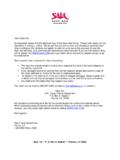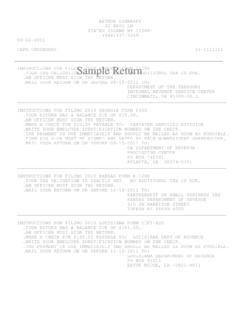Transcription of CAT5E/6 Impedance/Return Loss - unionszcn.com
1 CAT5E/6 Impedance/Return loss There is a new requirement making waves in the telecommunications industry. return loss (RL) is being specified in the newly ratified TIA/EIA TSB-95 Additional requirements for category 5 cabling and the proposed Category 5e and Category 6 documents. These specifications have brought a new awareness to the industry of an electrical parameter Belden has been promoting for a number of years. This paper will give a brief explanation of this new specification, why it is important, and what things may adversely affect the performance of the RL in your network. Additional installments will show the benefits of specifying Belden's bonded pair in the horizontal and patch cable areas to minimize the possibility of having RL problems in the end users network.
2 return loss return loss is one of many parameters regulated by the requirements established for Category 5e and 6 cables. It is a measure of the reflected energy from a transmitted signal. It is commonly expressed in positive dB's. The larger the value, the less energy that is reflected. The following figure illustrates return loss and it's effect upon the original signal. In the top portion, the signal is injected upon the pair. As the signal travels down the pair portions of the signal are reflected back to the transmitter. These reflections are caused by impedance discontinuities in the channel. These discontinuities may be due to several things such as connectors, improper installation or handling or improper manufacture.
3 Any energy that is reflected reduces the power of the transmitted signal Figure 1. The lower half of Figure 1 shows the effects when the echo is reflected back to the right. The reflected echo combines with incoming data, effectively smearing the signal and making it harder for the receiver to resolve the signal. A simple analogy for RL would be talking into a large long pipe or tunnel. When one calls out down the tunnel, the caller can hear his or her own voice echoing back while the person at the other end hears a smear of multiple echoes along with the original voice. This echo distortion is similar to the effects of RL upon the transmitted signal.
4 return loss can be calculated using the following equation: Zi = input impedance of the cable at a given frequency In a lab environment, the value of a measured RL value is a negative number. However, in an attempt to avoid confusion, the standards refer to all measured values in a positive format. For comparison to a specification, this conversion is accomplished by placing a negative sign in front of the equation. It is understood in the industry that the specifications in the standards may be converted into a negative format in the same manner. For simplicity, all the charts presented here will be in a negative format and all comparisons will be made to a converted standard.
5 Why is it important now? In 10 BaseT systems, two pairs are used for the transmission of data. Figure 2 represents a simple model of this system. Transmitters are indicated by the gray triangles pointing into the pair while receivers are pointed in the opposite direction. Looking at one end of the cable, one pair is transmits while another pair receives data from the opposite end. In this system the transmitter only sends data and is not listening for data from the other end. The reflected energy in this system does not affect the transmitter. Rather, it slightly attenuates and distorts the signal as it travels down the length of the channel to the receiver at the far end.
6 Figure 2. With newer systems such as 1000 BaseT, the pairs at each end of the cable are now required to simultaneously transmit and receive data. This means that, as the transmitter is sending data, it is listening for data from the other end on the same pair. This would be similar to someone yelling down that tunnel while listening for the other person who is yelling at the same time. Any words arriving from the other person would suffer from the echo distortion. However, the echoes of the first person's voice are bouncing back at the same time as the distorted voice arriving from the other end. In a network, as the signal is sent from the near end, a portion is reflected back at the transmitter.
7 This reflection mixes with incoming distorted data from the far end. This can make the interpretation of the transmitted data much more difficult. Figure 3. In a network, as the signal is sent from the near end, a portion is reflected back at the transmitter. This reflection mixes with incoming distorted data from the far end making the interpretation of the transmitted data much more difficult. What affects return loss ? return loss is generated through variations in the impedance of the channel. These variations can take the form of connectors with high or low impedance values. The average input impedance of the patch cables may be significantly different from the horizontal cable's average.
8 Additionally, the cables may have large impedance variations at specific points due to cable design instability. This instability can be attributed to the construction of the pairs and singles and may be aggravated by various handling and installation practices. In a simplified model, the channel is a highway for data transmission. Changes in impedance can be viewed as bumps and potholes, which may, depending on their severity, slow or stop the traffic flow of data. The RL is a measurement of how many "cars" are turned back due to the bumps and potholes versus how many actually made it to the end of the road. In short, RL can be interpreted as smoothness or uniformity measurement method for your cable or channel.
9 Connector return loss Connectors are a weak link in the channel's performance. Specifically, the split pair in the RJ-45 type connector is the major culprit. The physical separation of the conductors degrades the RL performance by disturbing the pair geometry. This separation of the pair generates an impedance discontinuity, causing signal reflections. Additionally, the near-end crosstalk (NEXT) compensation that some manufacturers performed on their older connectors aggravated the RL performance of the split pair. However, large improvements have been made to the new versions of connectors and this is becoming less of an issue making the cable performance more critical.
10 Cable return loss Parameters Cable return loss is regulated through two primary impedance parameters: the average input impedance and periodic impedance discontinuities. Each of these two parameters has several factors that affect their performance. Average Input impedance vs. return loss The unshielded twisted pair (UTP) systems Regulated by the ANSI/TIA/EIA-568-A document are 100 Ohm ( ). systems. When the average input impedance of a cable is different from 100 , the RL performance will decrease. The primary determining factor in the cable's average input impedance is the conductor to conductor spacing, however such things as jacket tightness or shields can also play a large role.






